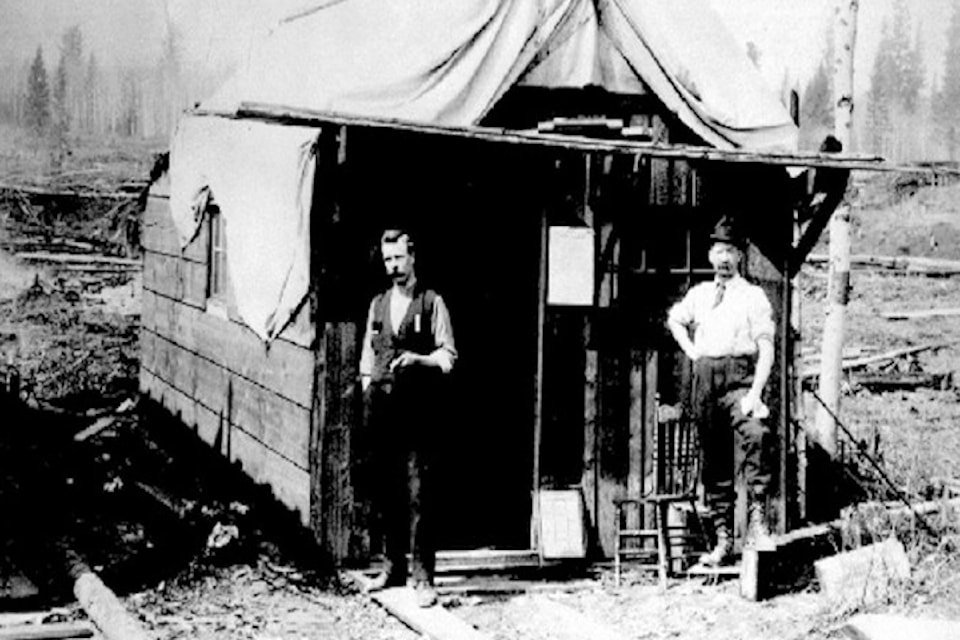Nelson, like so many British Columbia towns, was launched amidst the mining boom in the 1890s. It survived the inevitable depletion of the minerals. Others did not. Phoenix, Sandon and Yale prospered with the discovery of gold, silver or copper, only to disappear when the mines played out.
Osner and Winslow Hall made a discovery resulting in the formation of Nelson. In 1886, they led a gold prospecting trip from Colville, Wash. It was unsuccessful, but as they readied to head home, they discovered a large copper and silver deposit on Toad Mountain. By the winter of 1887, a miner’s camp had sprung up on Ward Creek at the base of the mountain.
The Hall family quickly built the Silver King mine. Getting the ore to a smelter was arduous. It was bagged by mine employees and dragged by horses down a mountain trail to Kootenay Lake. The bags were hauled to Bonner’s Ferry by steamboat and on to the smelter at Butte, Mont., by rail.
Meanwhile, magistrate GM Sproul laid out the townsite of Nelson. A lumber mill began operation, and frame buildings replaced the encampment. Lumber later became the area’s primary industry.
In 1891, the CPR built the Columbia and Kootenay Railway from Nelson to Robson (sited on the Arrow lakes). Steamboats linked to Revelstoke. Dubbed “the line from nowhere to nowhere,” it was little-used until the CPR expanded its rail system in 1898. In 1893, the Nelson and Fort Sheppard Railway was built to Nelson from the terminus of Spokane and Northern Railway at the U.S. border.
Hall Mines Limited, capitalized in London, England, purchased the mine in 1893, and three years later the company restructured to become Hall Mining and Smelting Co. Ltd. The firm constructed the smelter in Nelson. A tramway was built from the mine to the smelter, greatly increasing ore delivered and the economic benefit to the growing town.
In 1897, the City of Nelson was incorporated with an impressive population of 3,000. Nelson was the commercial centre of the region. John (Truth) Houston, who had established the town’s first newspaper, became the first mayor. He championed infrastructure for the city, defended the little guy and revealed corruption between the province and the CPR.
Houston was a business leader too. He built the Houston block on Baker Street. He and others founded the Nelson Electric Light Company in 1892. But he was often confrontational and imbibed liberally. He was convicted of assault three times in Nelson. In 1905, Houston abruptly vanished. He surfaced six weeks later, in Nevada. Still Nelson’s mayor, he resigned.
Nelson was the model of a progressive city at the turn of the 19th century. It was named the Kootenay Division Headquarters of the CPR. The city purchased the Nelson Electric Light Co. and an independent streetcar company. As the mining industry faded, other sectors expanded.
Nelson boasts a trove of architectural gems, the creation of resident, skilled architects Alexander Carrie and Alexander Ewart. Beginning in 1898, they “dominated the profession in boomtown Nelson for the next three years, designing dozens of commercial and residential buildings in a distinctive Queen Anne timber style that is still evident today,” according to Dictionary of Architects in Canada.
Ewart left Nelson, but Carrie stayed the rest of his life, designing scores of buildings, including the 1913 addition to the stunning Hume Hotel. The Hume, originally designed by Ewart, had opened in 1898. It still stands, but its distinctive features were eliminated in an unfortunate redesign in 1929. It is still impressive, but no longer emblematic of a refined, late 19th-century city.
Houston and city council, promptly upon election, had required brick firewalls on both sides of new commercial buildings, resulting in extensive use of stone and brick construction. The fire hall was expanded and fully equipped in 1898. This spared the city the devastating fires so prevalent elsewhere. Today, the historic downtown is amongst the finest in the province.
John Houston’s obituary was featured widely in the newspapers – while he was still alive. He responded in good humour, “Don’t be putting in any correction. I’ll make good on the promise.” And he did, just days later, the victim of pneumonia.
“Quite possibly, in fact, he did most of the things he was accused of – pocketing shareholders’ money from the sale of Nelson Electric, … manipulating voters lists, collecting ‘fees’ from brothels and firing a fire wagon driver for holding contrary political views,” writes kootenayhistory.com.
John (Truth) Houston was enigmatic. He was an accomplished mayor and business man, and at the same time, a rascal if not a scoundrel.
A column by Bruce Uzelman
Bruce Uzelman, based in Kelowna, holds interests in British Columbia history as wells as current political and economic issues.
Bruce had a career in small business, primarily restaurant and retail. He holds a Bachelor of Arts, Advanced from the University of Saskatchewan, with Majors in Political Science and Economics.
Contact: urban.general@outlook.com

